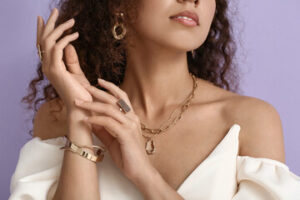Wild Ice Jewelry is a beautiful way to express yourself and an excellent gift for someone you love. It can conjure up memories and connections that last through generations.

Handmade jewelry is crafted with high-quality materials to ensure longevity. This makes it a more worthwhile investment than mass-produced jewelry.
Jewellery is a powerful form of self-expression, conveying messages about identity, social status, emotions, and values. It can also act as a tangible memory of relationships and experiences. Some people choose to wear jewellery with specific symbols that represent social or environmental issues. Others use jewelry to express their personal style and sense of fashion.
Throughout history, people have worn jewellery to enhance their physical appearance and portray a stronger image of themselves. Archeological finds show that jewellery was a staple in prehistoric societies, and was used to distinguish between different groups. Jewellery was made from wood, stones, metals, and shells to be worn on the body. It was believed to bring good luck and protection. It was also a symbol of wealth, power, and nobility.
Today, people continue to wear jewellery as a way to showcase their unique styles and personalities. The art of jewellery is constantly evolving, with new trends and materials being introduced. Some of the most notable changes came with the “jewellery as art” movement, which was led by designers and artisans such as Rene Lalique in France. This style emphasized artistic design and craftsmanship.
Moreover, the jewellery was designed to reflect cultural and historical influences, with influences from other forms of art such as sculpture, painting, and architecture. In addition, the jewellery was adorned with meaningful and symbolic icons such as flowers and animals to symbolize love and friendship.
It’s a form of fashion
Jewellery is a form of fashion and beauty that has been worn throughout history. It can be artistic/decorative, functional (such as to hold hair in place or to fix clothing), or a sign of status. In addition, it can be a personal symbol of meaning or belonging (such as the Christian crucifix or the Jewish Star of David).
Jewels and jewellery have been produced for over 100,000 years. The oldest known examples were beads made from Nassarius shells. The art of jewellery has evolved over time, with influences from esthetic concepts, cultural dictates and even religious beliefs. The evolution of jewellery has also reflected the changing needs and desires of society.
Today, jewellery can be found in all shapes and sizes, with the most common being earrings, necklaces, bracelets, brooches and rings. The jewellery industry is a very diverse one, with designers and craftspeople producing pieces for a range of tastes and occasions. The majority of people have a mix of fashion, semi-fine and fine jewellery in their closets – depending on how much they wear everyday and what they want to wear for special occasions.
The spelling of jewellery differs between varieties of English, with the American spelling prevailing by about two to one. The spelling is also different in other languages, such as French, German and the Latin word joaillerie. The term is also used to refer to decorative articles, notably carved or engraved gemstones.
It’s a form of art
Jewellery is generally viewed as a form of body adornment or a symbol of wealth. However, for some it’s also a form of art and design. Its history spans thousands of years and has been used by almost every culture. While it can be difficult to pin down exactly what constitutes jewellery as a form of art, some experts have made their best attempts.
A jewelry designer is a skilled individual who uses his or her technical knowledge to create pieces of art that are functional and aesthetic. They can use various materials including metal, glass, and ceramics to produce unique pieces of jewellery. They are often trained in a specific field, such as welding or machining, before beginning their career as a jewelry designer.
Sculptors are particularly adept at designing jewellery, as they are accustomed to working in three dimensions and exploring space through tangible works that appeal to the visual and tactile senses. They may also employ a new approach to traditional materials and techniques to create strikingly innovative pieces.
It is important to note that jewellery can be both decorative and functional, as in the case of a gold, sapphires, and diamond Boule de Geneve. It can also be a mark of status or a symbol of love, such as a wedding ring. Moreover, it can also be a means of protest and self-expression. For example, a man might wear earrings to signify that he is gay or lesbian.
It’s a form of adornment
Jewelry has long held a place in culture, as a form of adornment and beauty. It can be worn to show status, or to commemorate important events and milestones. It can also carry a great sentimental value for the owner. For example, many people wear rings to show that they are married. Jewelry has a very long history and can be traced back to ancient times. It can be made of precious metals or gemstones. It can also be used to express a person’s style and personality.
In the modern era, jewellery has become a fashion accessory. It is often a symbol of love and friendship, and can be passed down through generations. It can even be a form of art. Many jewelry designers combine traditional styles with modern trends to create unique pieces.
Jewellery is the noun referring to articles of gold or silver, or sometimes precious stones, that are worn as ornaments. It may be functional (such as a brooch) or decorative (such as a necklace). The word is spelled differently in different varieties of English, including jewelry and jewellery.
The emergence of industrialisation and mass production brought about new forms and styles of jewellery. For instance, the work of Georg Jensen introduced a more sculptural approach to jewellery. This movement was also marked by the introduction of new materials, such as aluminium.
It’s a form of communication
Jewelry is a powerful form of communication that can convey a lot of information about the wearer’s personal values and aesthetic. The choice of materials and design can also imply an individual’s preferences and beliefs.
Many pieces of jewelry serve as reminders of milestone events in people’s lives, such as graduations and weddings. They can become treasured symbols of these memories and become a source of joy and happiness when worn later in life. Others may serve as markers of membership in a group, such as the rings worn by men affiliated with a Masonic fraternity or the pins worn by nurses and Girl Scouts.
Some jewellery is plated in order to give it a shiny appearance and achieve a certain colour. For example, sterling silver pieces are plated with gold or rhodium to achieve a brighter finish. This process is called flashing. Other materials that are plated in this way include copper and zinc.
It’s a form of memory
Jewelry is a form of memory that can preserve and honor departed loved ones. It can help comfort those who are grieving, and it can become a treasured symbol of the bond that was shared. Memorial jewellery can also be a way to celebrate significant milestones, such as graduations, engagements, weddings, or anniversaries.
Throughout the history of humankind, jewellery has been a symbol of status and wealth. It has been used to mark social status, as a sign of good taste, and as a way to express individuality. Throughout the ages, jewellery has been crafted from a variety of materials, including precious metals, gemstones, beads, and shells.
Today, the craft of jewellery has expanded to include a wide range of forms and materials. Jewellery designers use 3D printing technology to create complex shapes that are difficult or impossible to produce by hand. The process allows them to experiment with new ideas and techniques while creating unique and personalized pieces.
The spelling of the word “jewellery” varies depending on the region in which it is spoken. The spelling “jewelry” is preferred in American English, while “jewellery” is more common in other varieties of English. The difference is subtle, but it can affect pronunciation. The spellings are influenced by different factors, such as the influence of French and other languages on English. Samuel Johnson’s Dictionary of the English Language influenced the standardisation of English spelling.
